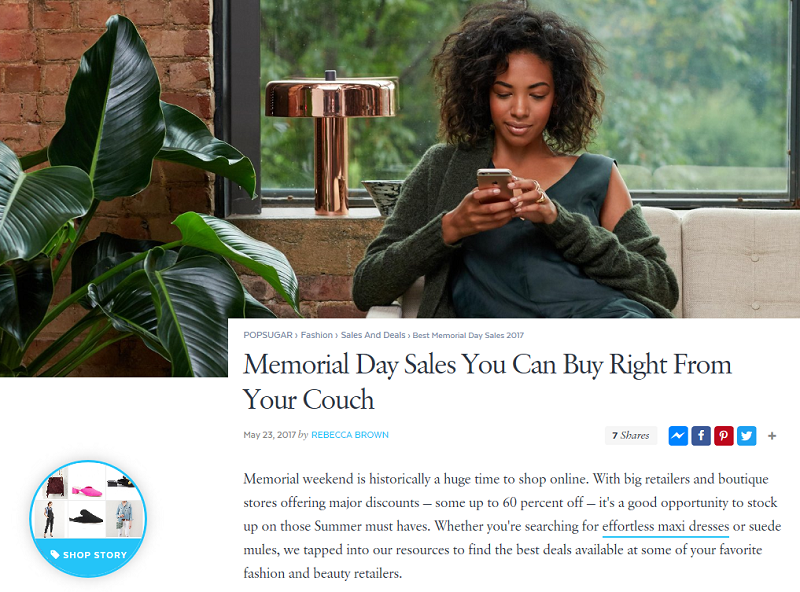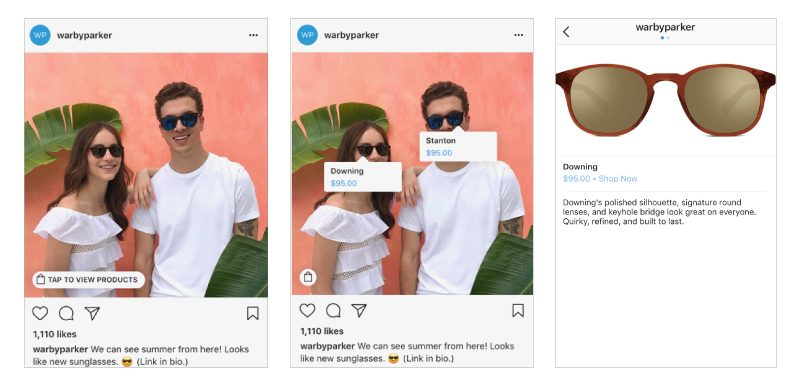
Up until recently, content marketing and product promotional efforts were, for the most part, separate parts of an e-commerce business’s marketing strategy. But with smarter technologies and bigger data, it was inevitable that the two would join forces.
Enter: shoppable content.
What Is Shoppable Content?
Your ultimate goal has always been to convert interested consumers into paying shoppers. That’s why you create high-quality content for your brand: to establish a genuine connection and trust with them, hoping to inspire them to make a purchase. While you could promote your products or those of your affiliate partners within your content, it always requires that readers click out and away from the page in order to make a purchase.
Many businesses have found that there is just too much friction between content consumption and the shopping experience. By integrating the shopping experience within photo, video, blog, and social media content, though, businesses can now cut down on that friction and make it easier for consumers to convert.
Imagine you published an article about the benefits of wearing the right shoe size when working out. Within the article, you linked to five different workout sneakers sold on your site. Rather than readers having to click through each link and abandon the article that contains the helpful information, shoppable content technology instead enables you to consolidate all the shoppable “content” (basically, a list of the products mentioned) into one area or widget so that readers can easily peruse and add them to their shopping cart whenever they want.
Who’s trying it?
Want to see some real-world examples of how companies are moving the shoppable content trend forward?
PopSugar has a new widget in the bottom-left corner of certain articles. When readers click on it, they have a chance to “Shop the Article” without having to go to the product page to add the items to their cart.
Warby Parker is among U.S.-based retailers sharing posts on Instagram featuring an icon encouraging users to “Tap to view products.” When tapped, a tags appear on various products featured in the post (up to five products per post). A user selecting one of those tags is then provided a detailed view of the selected product and a link to buy.
Kate Spade worked with Cinematique to create touchable video content. Users can click on different elements in the video and get product info, humorous side notes, as well as shopping cart links as they discover new things to explore.
As more companies jump on board this trend, we’re now starting to see the results of shoppable content, too.
When Adobe surveyed users about their experience with shoppable content, they found that “77 percent of those who viewed the shoppable site found it easier to navigate” and “66 percent of those who used the shoppable site got enough information to make a purchase decision.”
PopSugar also published some insights they were able to glean from the addition of shoppable content to their articles: “In our study, we learned that 67 percent of millennial women wish that they could take advantage of the benefits of shoppable content and instantly purchase the products they see in digital content.”
Considering it for Your E-commerce Brand?
All this sounds well and good, right? But how realistic of an option is this for small- to medium-sized e-commerce companies?
Here are some things to consider first:
- Many of the aforementioned companies are working with third parties to create tagged videos or images, 360-degree experiences, and more.
- Part of the reason why companies like PopSugar have been so successful is because of the extensive user analysis and testing they’ve done to figure out what exactly their consumers want from shoppable content.
- Shoppable content pins, tags, related purchase popups, etc. are really cool for helping conversions along, but you never want to use them if they break with the UI design you’ve already established, and visitors have become comfortable with.
- If you start creating content for the sake of using shoppable content tricks, your audience will notice. Your content needs to remain relevant, insightful and helpful. The shoppable piece should only be there to streamline the conversion process that was already in place.
- You can’t cut corners with shoppable content. If you try to create this on your own or use technology that isn’t proven to work, you might further aggravate or disrupt the consumers’ online shopping experience.
But hey, there are a lot of good things about shoppable content, too:
- It’s another way to improve the online experience consumers have with your brand.
- It taps into emotional shopping by directly connecting your content to your solution.
- It will definitely help separate you from the competition.
- It gives you a new way to spice up video and image content on social media.
- It may attract new and better business partners and linking opportunities when they see how well your shoppable content works.
Just remember: this is just another type of marketing you can consider using. There’s no right or wrong way to go with content marketing so long as it works for you and your consumer. So, if shoppable content looks like it’s a viable option and you’re in a position where this makes sense for your brand, why not give it a shot?
About Endicia
Endicia is a leading provider of internet-based postage services that make it easier and more affordable to ship parcels through the U.S. Postal Service®. We know that shipping can be complex and our goal is to simplify your shipping operations so you can focus on doing what you do best. Visit us at endicia.com to learn more.






